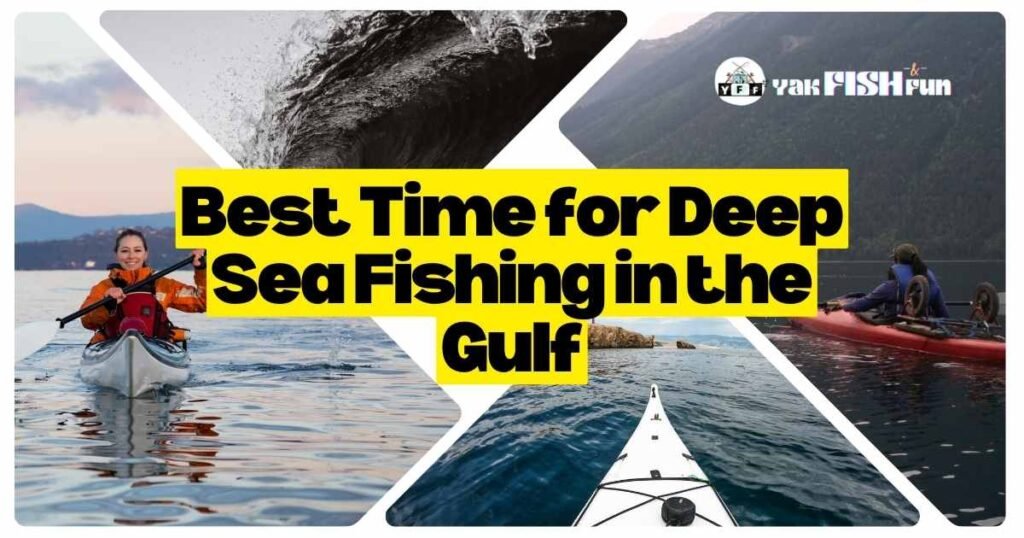Do you crave the thrill of adventure? Are you seeking a unique fishing experience that will leave you in awe? Look beyond the traditional fishing charters and dive into the exhilarating world of deep-sea kayak fishing in the Gulf.
The salty breeze caresses your face as you cast your line into the deep waters, ready to reel in a big catch. The Gulf of Mexico beckons with its abundant marine life and stunning scenery, offering an unmatched opportunity for anglers like yourself.
But when is the best time for deep sea fishing in the Gulf?
The best time for deep-sea kayak fishing in the Gulf of Mexico is typically during the spring, summer, and early fall months when water temperatures are warmer and fish are more active. Fishing during calm seas, favorable tides, and specific moon phases can also enhance your chances of success.
However, the precise timing can vary based on location and target species, so local knowledge and research are crucial for optimal results.
In this article, we’ll uncover seasons when fishing opportunities are at their peak and introduce you to species like blackfin tuna and pelagic fish that call these waters home. We’ll discuss essential gear and baitfish choices for a successful outing.
Table of Contents

Best Time to Go Deep Sea Fishing in the Gulf
The best time for deep sea kayak fishing in the Gulf is when it’s warm outside, and the water is comfortable for fish. This usually happens in the warmer months. But, you should also think about things like when fish move around, the weather, and the tides to make sure you have the best chance of catching fish on your fishing trip.
Let’s explore them.
Water temperatures
In the Gulf, the water temperature changes during the year. The best water temperature for deep sea kayak fishing is usually between 20°C and 28°C (68°F and 82°F). This temperature range is just right for many kinds of fish, including popular ones like snapper, grouper, and king mackerel.
During the summer months, the Gulf’s water is warmer, and that attracts lots of different fish. You’ll often find red snapper, grouper, and king mackerel during this time. But if you’re looking for specific fish like sailfish or tuna, it’s better to go fishing when it’s a bit cooler in the Gulf.
Here’s a short guide to help you get the most out of it.
- Yellowfin Tuna: Yellowfin tuna like warm water, usually around 75°F (24°C) or a bit warmer. These strong and popular game fish are usually in the warm tropical and subtropical areas of the Gulf of Mexico.
- Redfish: Redfish, also called red drum, do best in cooler temperatures, specifically around 60°F (15°C). They are known for being able to live in various places and are often seen in the Gulf’s waters near the shore and in areas close to the shore.
- Snapper: Various snapper species, like Red Snapper, are typically found in waters ranging from 64°F to 82°F (18°C to 28°C). They are commonly sought after by anglers for their delicious meat.
- Grouper: Grouper species, including Gag Grouper, prefer water temperatures between 66°F to 77°F (19°C to 25°C). They are known for their size and strength.
- Mahi-Mahi (Dorado): Mahi-Mahi is often found in waters between 70°F to 86°F (21°C to 30°C). These colorful and acrobatic fish are known for their preference for warm, tropical waters.
In the summer, the Gulf’s water gets hotter, especially in July and August. This warm water brings more fish, which is great for deep-sea kayak fishing. But, it’s important to know that during this time, there can be tropical storms and hurricanes in the Gulf. So, you should keep an eye on the weather and be careful.
Migration Patterns
The way fish move around is really important for deep sea kayak fishing in the Gulf. Some types of fish come to the Gulf at certain times of the year, so it’s smart for fishermen to plan their trips based on this. For instance, there’s a yearly migration of tarpon in the Gulf, usually from April to August. During this period, lots of tarpons gather in the Gulf, which gives kayak fishermen a great chance to catch them and have an exciting time.
Weather conditions And Tides
Besides water temperature and fish movement, you should also think about two more things: the weather and tides. Sometimes, the Gulf has strong winds and rough seas, so it’s really important to check the weather forecast before you go out on your trip.
Also, knowing about tides can help you figure out the best times to fish. Some fish are more active during certain phases of the tide, so this can be a big help in planning your fishing adventure.
Weather Patterns, Barometric Pressure, and Fishing Seasons In The Gulf
The Gulf of Mexico is like a dream come true for people who love fishing. You can catch all sorts of different fish and have amazing experiences here. There are big fish like Yellowfin tuna in the warm, tropical parts and other fish like Redfish in the cooler areas near the coast.
However, beneath the Gulf’s beauty lies a complex interplay of complicated stuff going on in the Gulf. Things like the weather, air pressure, and the time of year really affect how many fish there are and how they act.
Seasonal Weather Patterns
The Gulf has different types of weather at different times of the year. Each season has its own good and bad sides. If you love deep-sea kayak fishing, it’s crucial to know about these seasonal weather changes. This knowledge helps you figure out when to go fishing, what kind of fish to aim for, and how to get ready for the specific weather during each season.
Let’s have a glance at it.
Summer: Warm Waters and Trophy Fish
Summer brings warm waters and trophy fish to the Gulf. This season is known for its high temperatures and increased fish activity. You can try to catch large game fish like sailfish, wahoo, and marlin because there are more of them in the warm Gulf waters. But be careful, summer can also bring tropical storms and hurricanes, so you need to keep an eye on the weather.
Fishing Tip: Troll near offshore rigs and platforms for a chance to land trophy fish. Be sure to keep an eye on weather forecasts and be prepared for changing conditions.
Winter: Cooler Challenges and Unique Opportunities
Winter in the Gulf brings cooler water temperatures and unique fishing opportunities. While some anglers may shy away from the colder months, winter can be rewarding for those who venture out. Species like sheepshead and black drum thrive in the Gulf’s cooler waters. Additionally, winter provides a chance to target offshore species like yellowfin tuna, which prefers slightly cooler temperatures.
Fishing Tip: Use a depth finder to locate schools of yellowfin tuna in deeper waters during the winter. Dress warmly and be prepared for occasional temperature drops.
Fall: Transition and Migration
Fall signals a transition in the Gulf as fish species begin to migrate. Cooler temperatures start to prevail, and anglers can expect species like king mackerel and Redfish to move closer to shore. This season offers a mix of opportunities as fish prepare to head south for the winter. It’s a great time for both inshore and offshore fishing.
Fishing Tip: Target nearshore and offshore reefs during the fall to intercept migrating species. Live bait and artificial lures can be effective in attracting a variety of fish.
Barometric Pressure and Its Impact
Barometric pressure, often referred to as atmospheric pressure, is a crucial factor influencing fishing conditions in the Gulf of Mexico. It measures the weight of the atmosphere above a specific location and can vary from day to day. Understanding these pressure changes is essential because they can significantly affect fish behavior.
How High and Low-Pressure Systems Affect Fishing
Fish can feel when the air pressure changes, and it affects how they act. When the pressure is high and the weather is clear and calm, fish tend to be less active. But when the pressure is low and there are clouds, rain, or storms coming, fish become more active because they can sense the changing weather.
During periods of falling barometric pressure, fish tend to be more active and are more likely to bite. Plan your fishing trips accordingly, but stay safe and be prepared for changing weather conditions.
Bottom Line
To conclude, summer is the best time to go deep sea fishing in the Gulf. However, weather patterns play a crucial role in determining when it’s prime time for deep-sea fishing in the Gulf. Keep an eye out for stable weather conditions with minimal wind and clear skies. These calm days provide ideal conditions for both fish and anglers alike.


